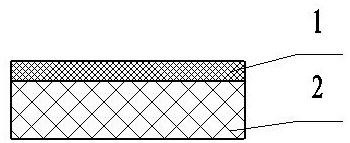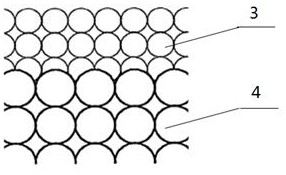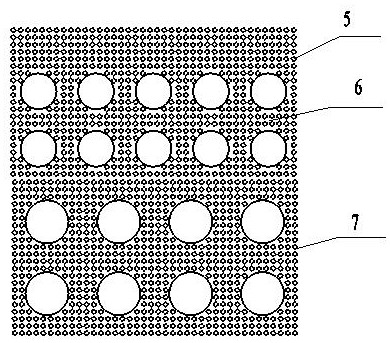Bracket for joint repair
A joint and porous metal technology, applied in the field of prosthesis, can solve the problems of unsatisfactory force transmission, damaged stent, insufficient strength, etc., and achieve the effects of good buffer function, good force transmission, and good seepage characteristics.
- Summary
- Abstract
- Description
- Claims
- Application Information
AI Technical Summary
Problems solved by technology
Method used
Image
Examples
Embodiment 1
[0037] The bracket for joint repair in this embodiment is composed of a porous polymer material layer 1 and a porous metal material layer 2 from top to bottom. Porous polymer material layer 1 adopts type I collagen, its pore diameter is 3 μ m-10 μ m, porosity is 70%, and thickness is 3 mm, porous metal material layer 2 is porous niobium, wherein porous niobium has two layers, see figure 2 , wherein the porous niobium upper layer 3 (first layer) connected to the porous polymer material layer 1 has a pore diameter of 50 μm-80 μm, a porosity of 37%, and a thickness of 2 mm. The porous niobium lower layer 4 (second layer) has a pore diameter of 100μm-500μm, the porosity is 82%, the thickness is 4mm, and the pores inside and between the layers of porous niobium materials are interconnected. The preparation method of the bracket for joint repair is as follows:
[0038] (1) Prepare the porous niobium upper layer 3 (the first layer) by the foam soaking method.
[0039] (2) Prepare ...
Embodiment 2
[0045] The scaffold for joint repair of this embodiment is similar to that of Embodiment 1, except that the porous metal material layer is a porous nickel-titanium alloy, the pore diameter of the first layer is 70 μm-100 μm, the pore diameter of the second layer is 500 μm-1000 μm, and the porous height is The molecular material layer adopts type II collagen and chitosan, and its volume ratio is 3:2. The preparation method is similar to Example 1.
Embodiment 3
[0047] The scaffold for joint repair in this embodiment is composed of a porous polymer material layer and a porous metal material layer sequentially from top to bottom. The porous polymer material layer uses type II collagen and chitosan (the volume ratio is 3:2) as raw materials, and the thickness is 3.5mm. The porous metal material layer is porous titanium, which is a three-layer gradient porous material, see image 3 , the porous titanium upper layer 5 adjacent to the porous polymer material layer has a pore diameter of 3 μm-10 μm and a thickness of 1 mm, the porous titanium intermediate layer 6 has a pore diameter of 50 μm-70 μm, and the cavity wall material of the pores is the above-mentioned pore diameter of 3 μm- 10μm porous titanium material with a thickness of 2mm, the pore diameter of the porous titanium bottom layer 7 is 100μm-600μm, and its cavity wall material is the above-mentioned porous titanium material with a pore diameter of 3μm-10μm, and a thickness of 4mm...
PUM
| Property | Measurement | Unit |
|---|---|---|
| pore size | aaaaa | aaaaa |
| pore size | aaaaa | aaaaa |
| size | aaaaa | aaaaa |
Abstract
Description
Claims
Application Information
 Login to View More
Login to View More - R&D
- Intellectual Property
- Life Sciences
- Materials
- Tech Scout
- Unparalleled Data Quality
- Higher Quality Content
- 60% Fewer Hallucinations
Browse by: Latest US Patents, China's latest patents, Technical Efficacy Thesaurus, Application Domain, Technology Topic, Popular Technical Reports.
© 2025 PatSnap. All rights reserved.Legal|Privacy policy|Modern Slavery Act Transparency Statement|Sitemap|About US| Contact US: help@patsnap.com



